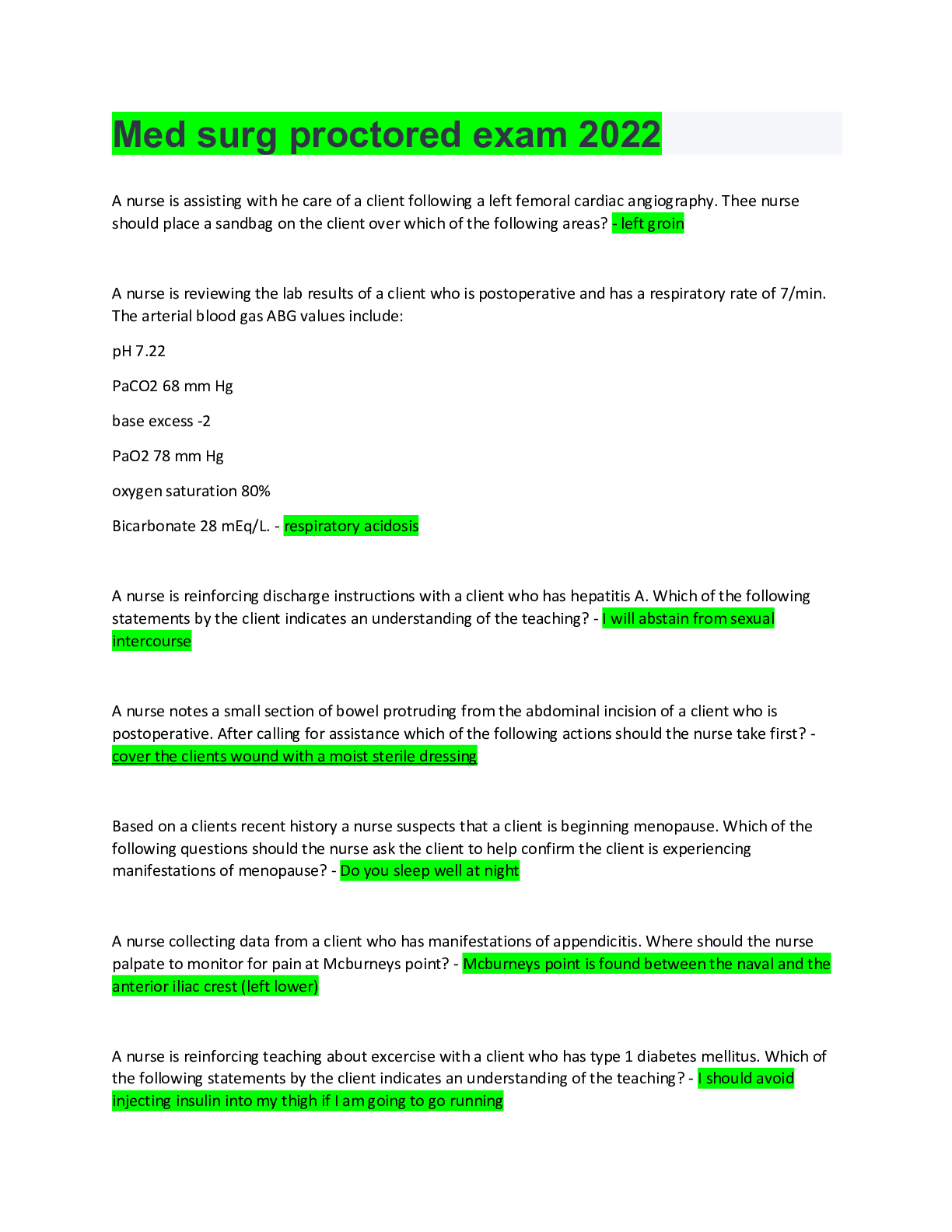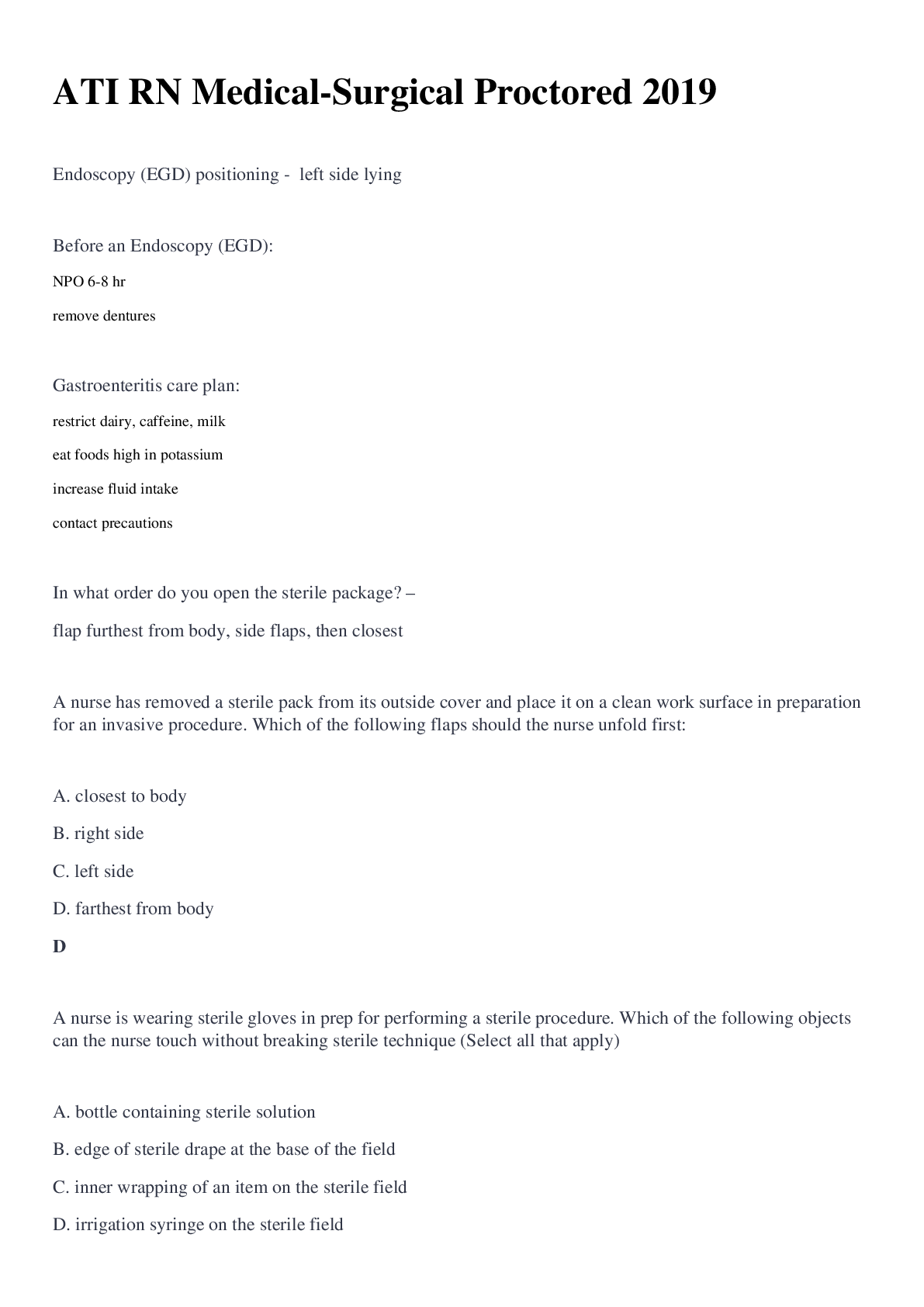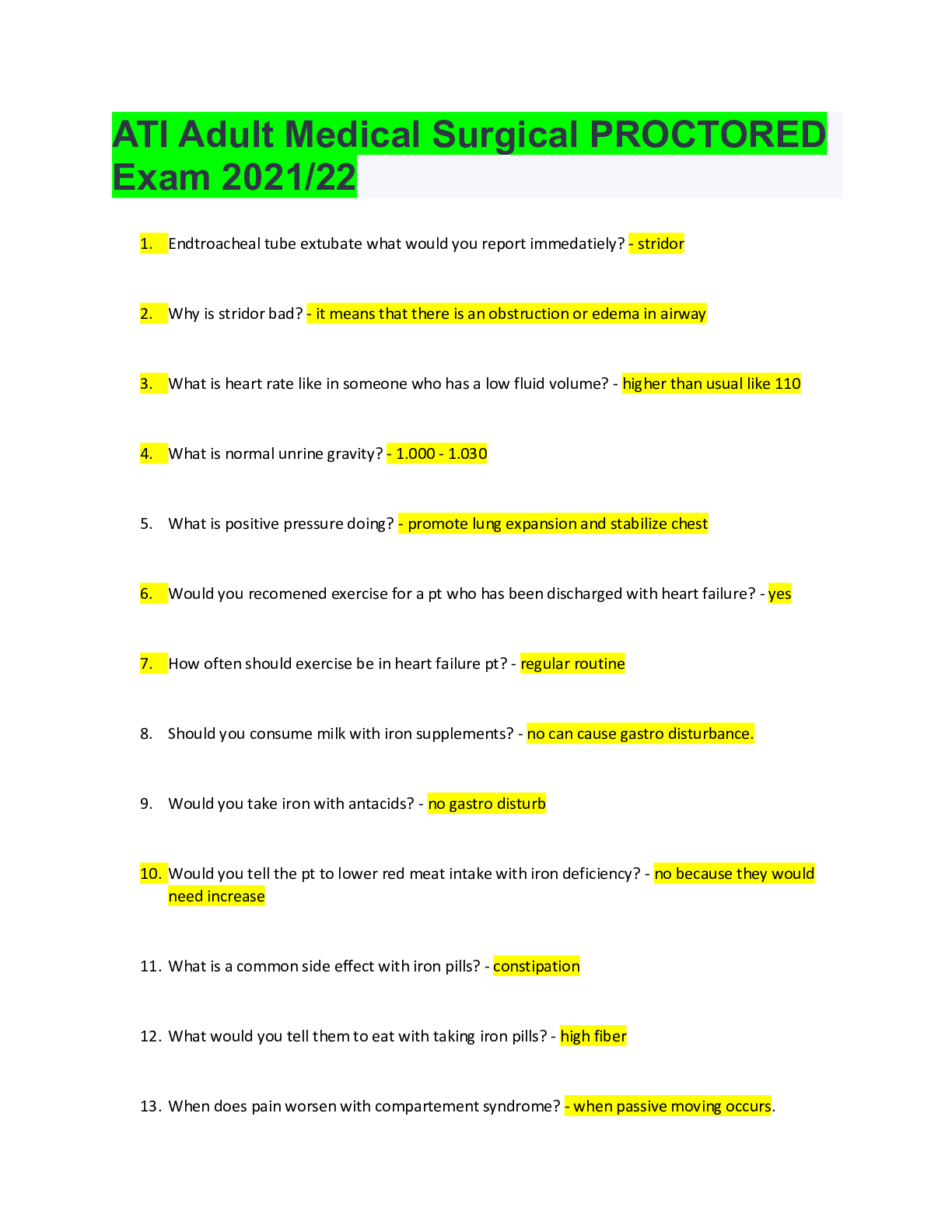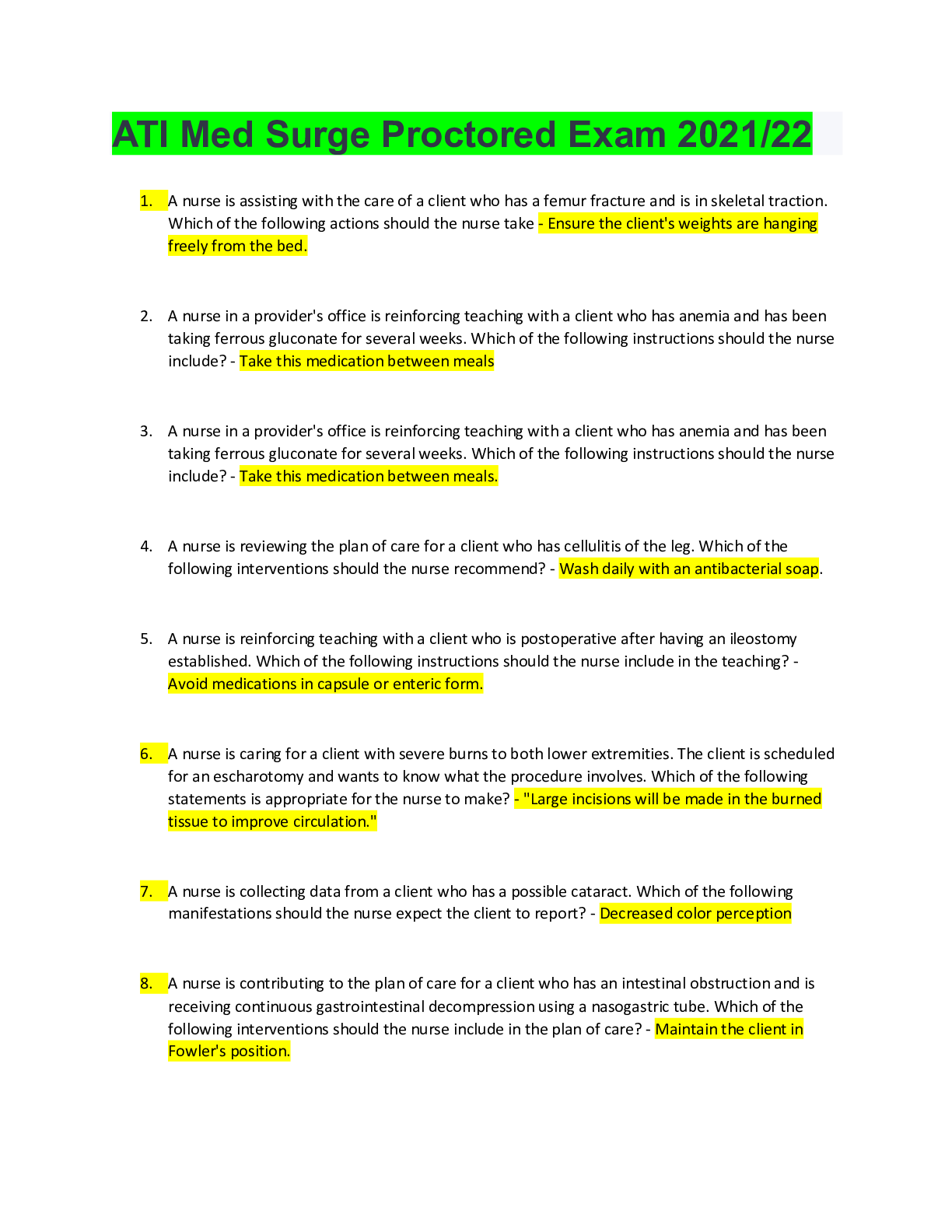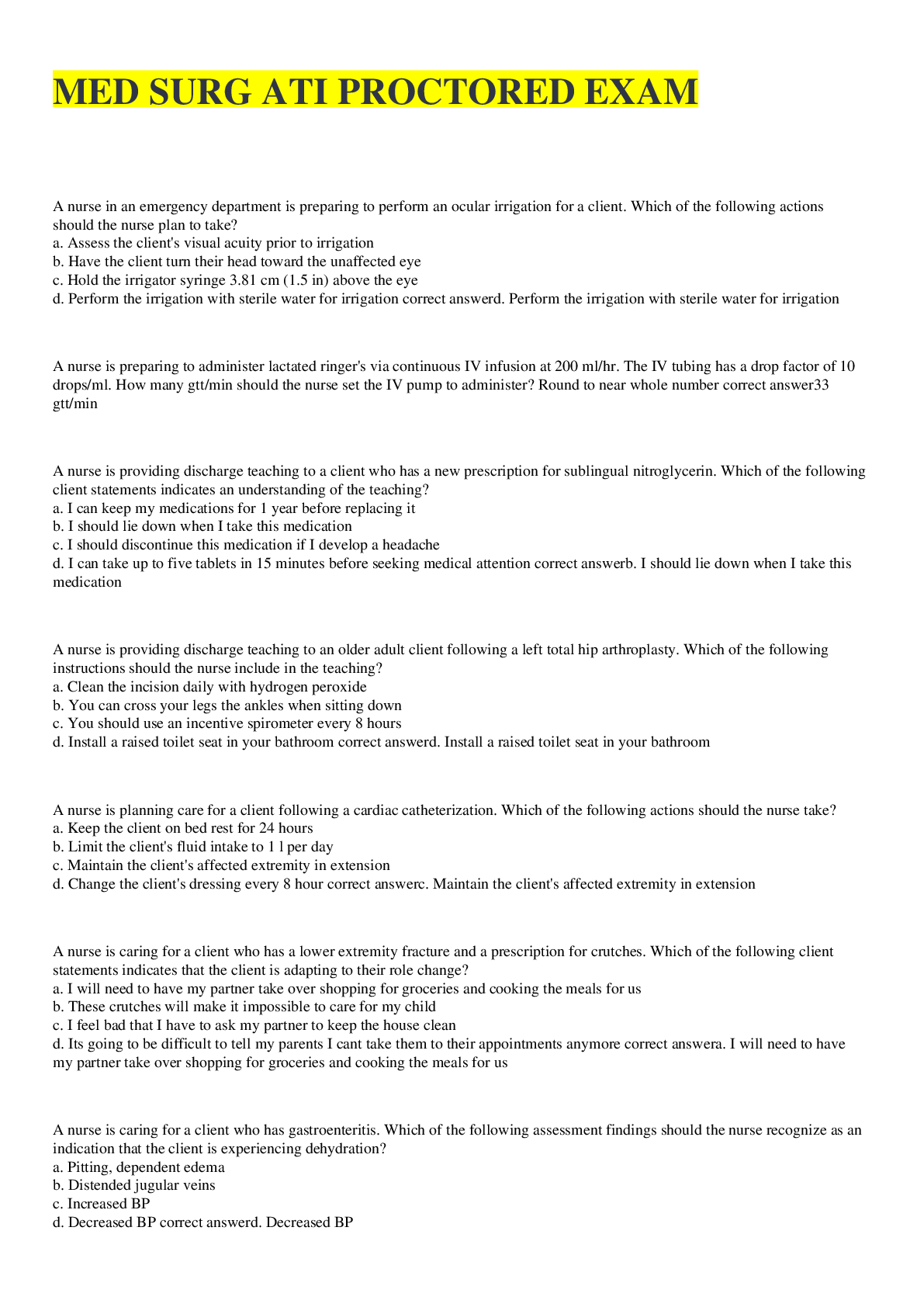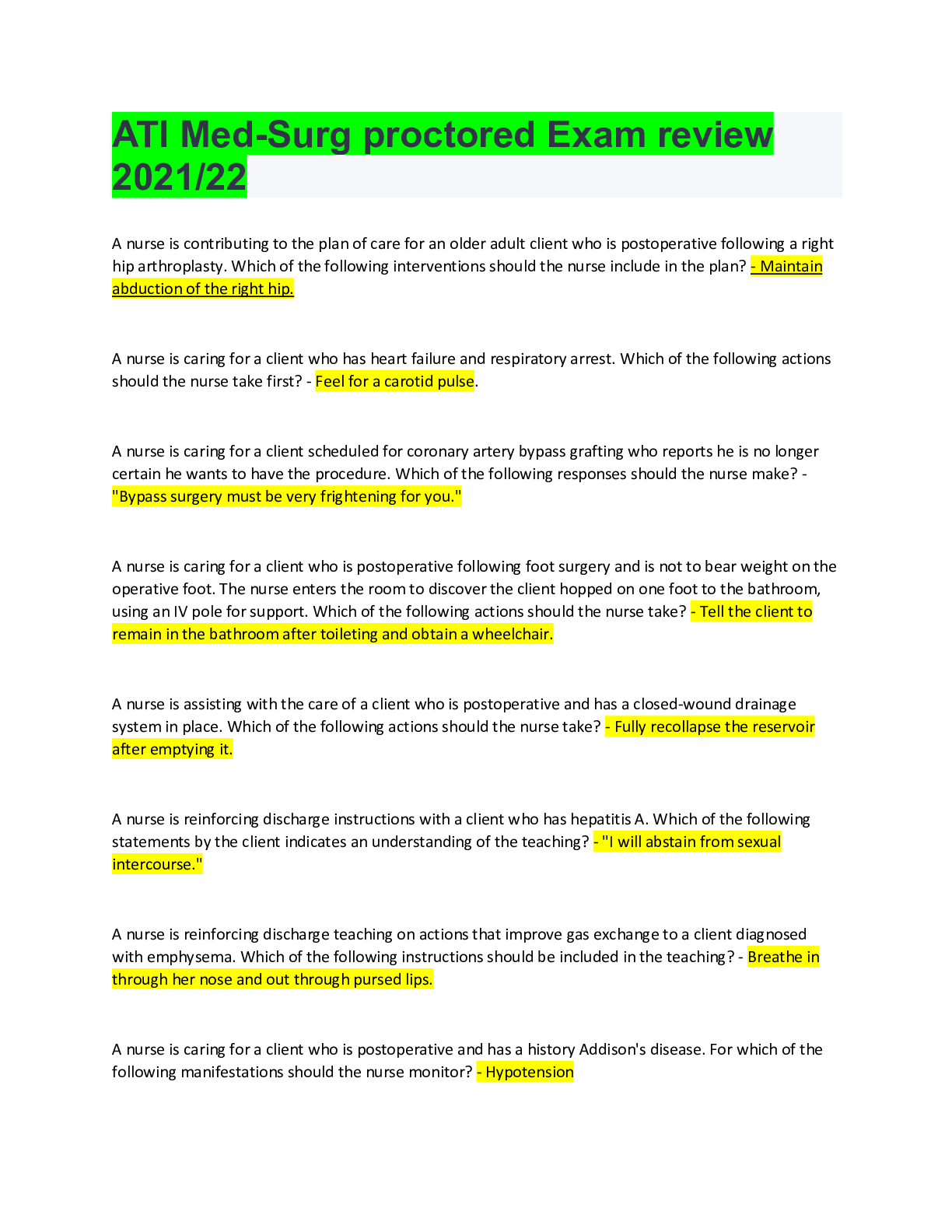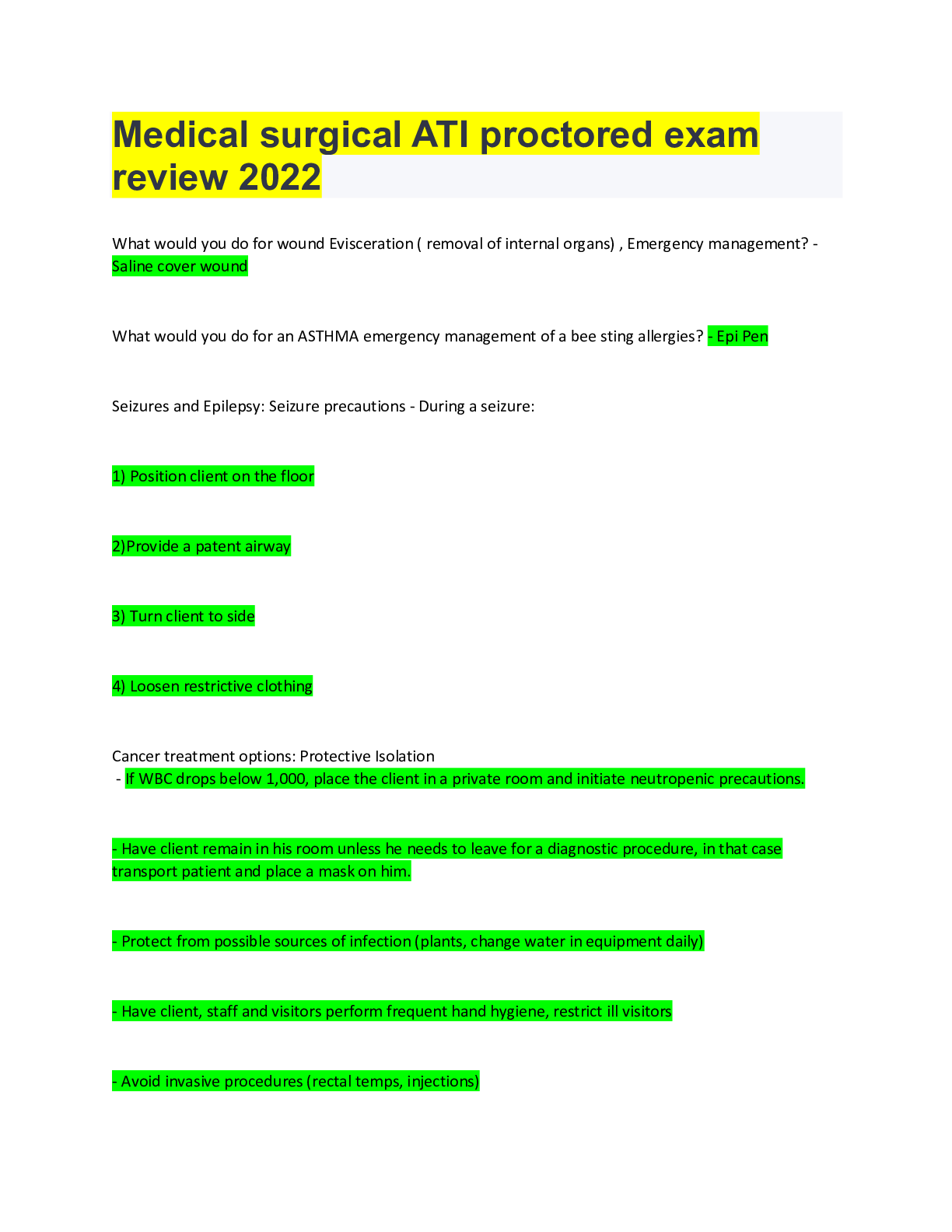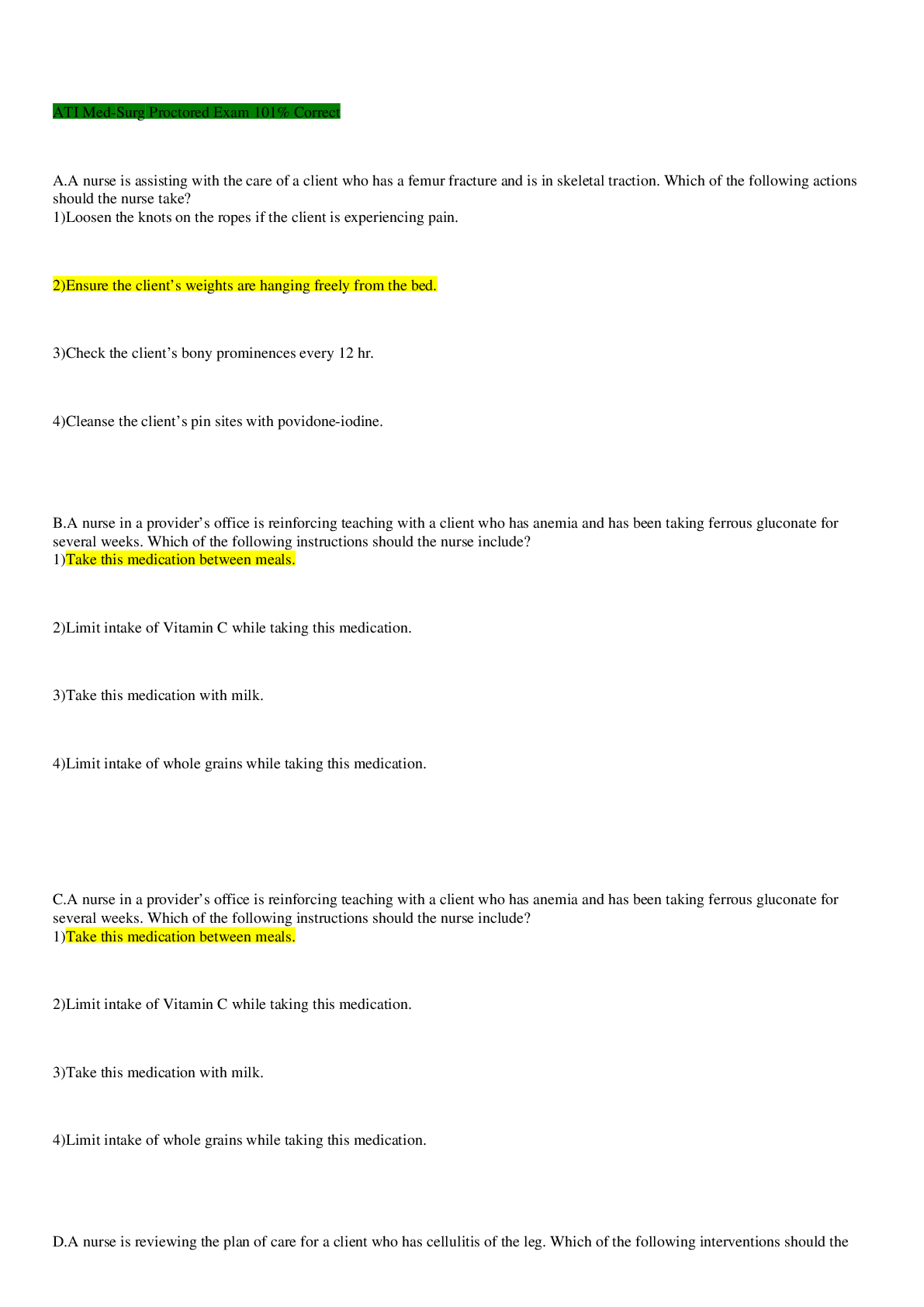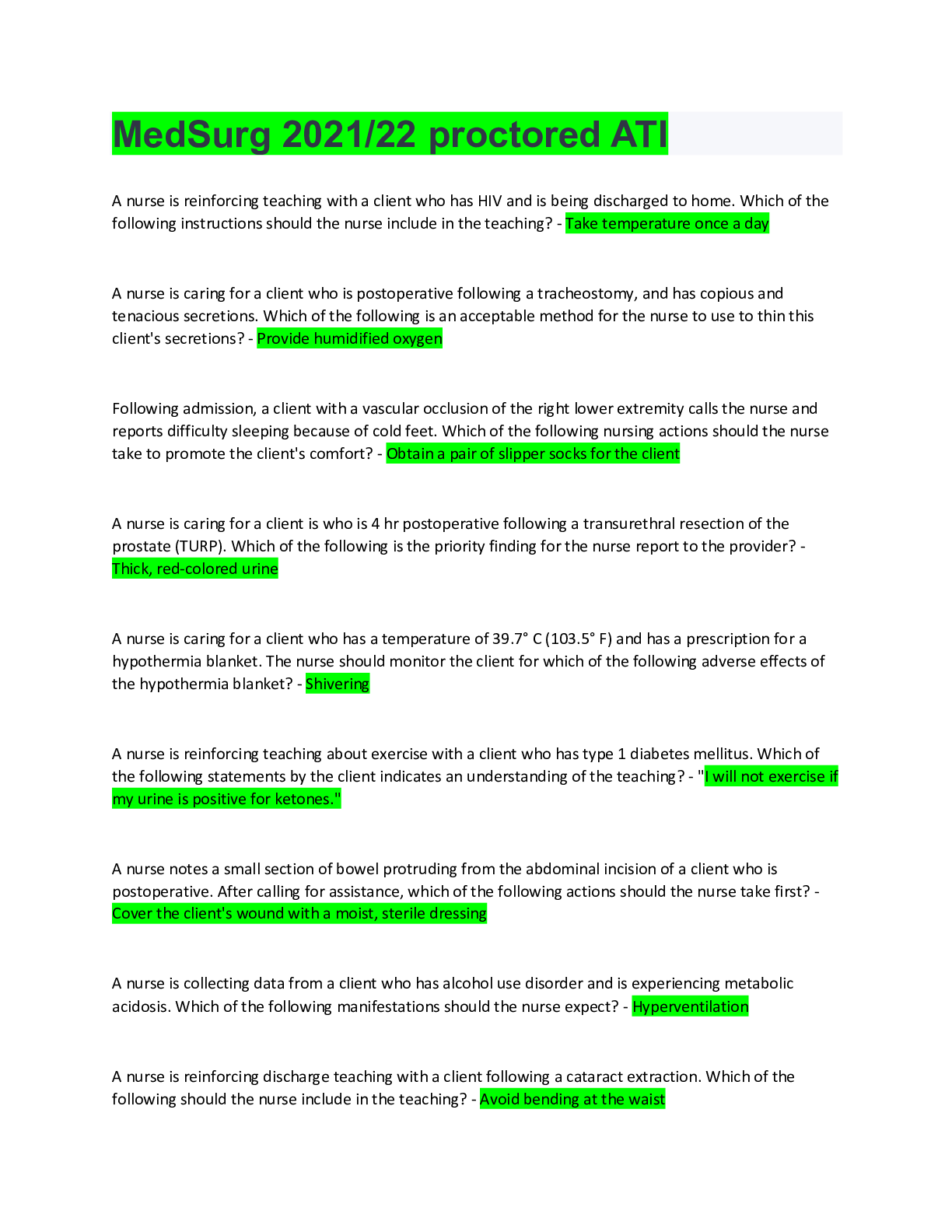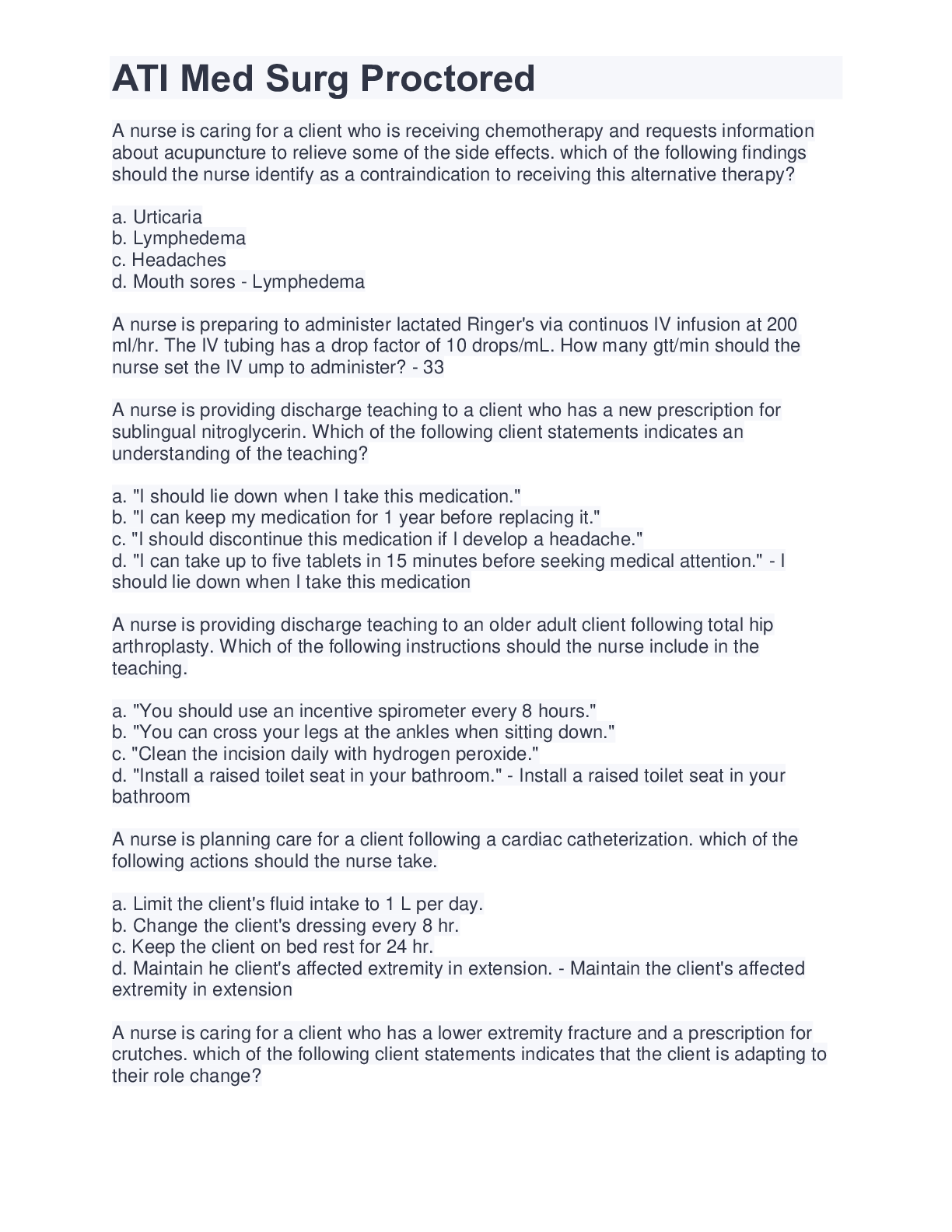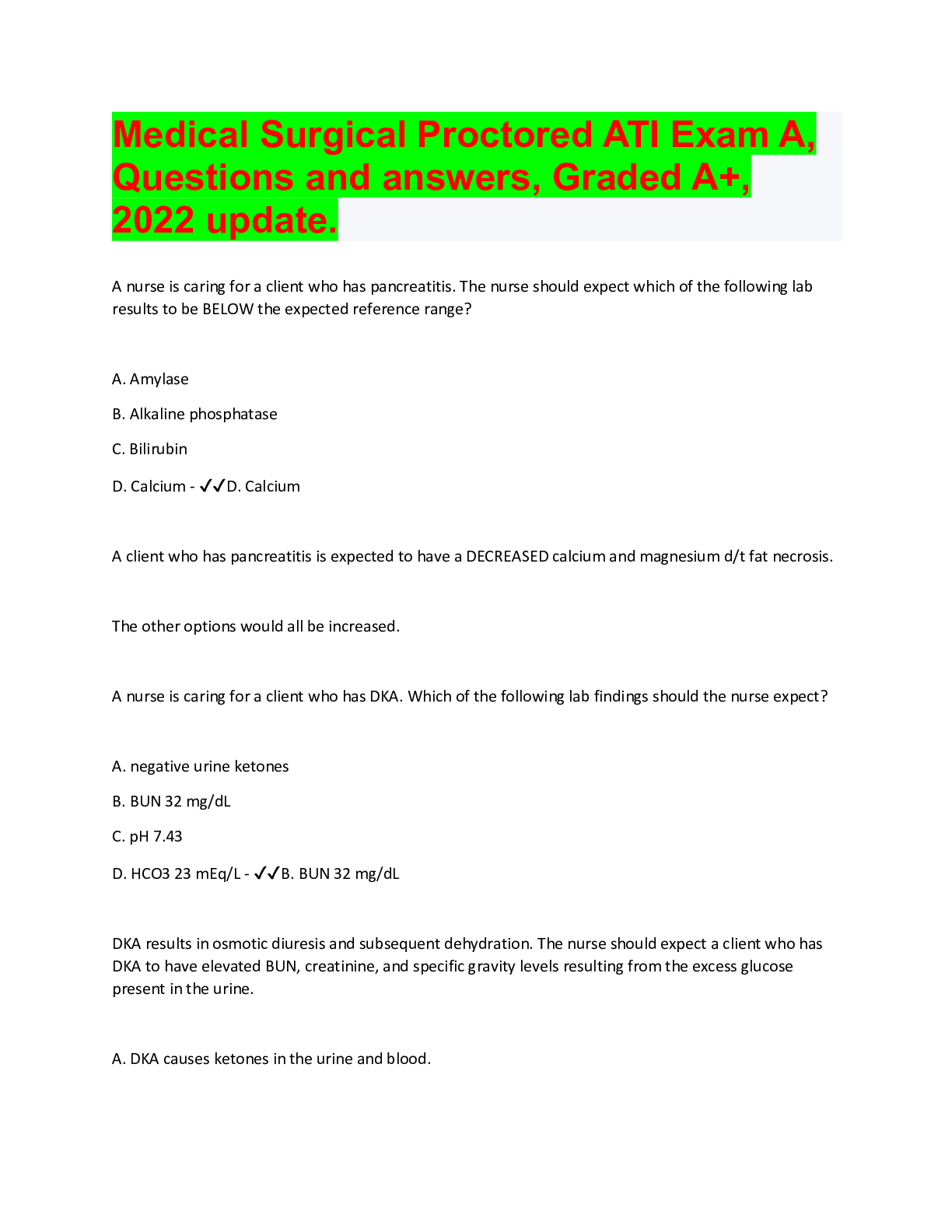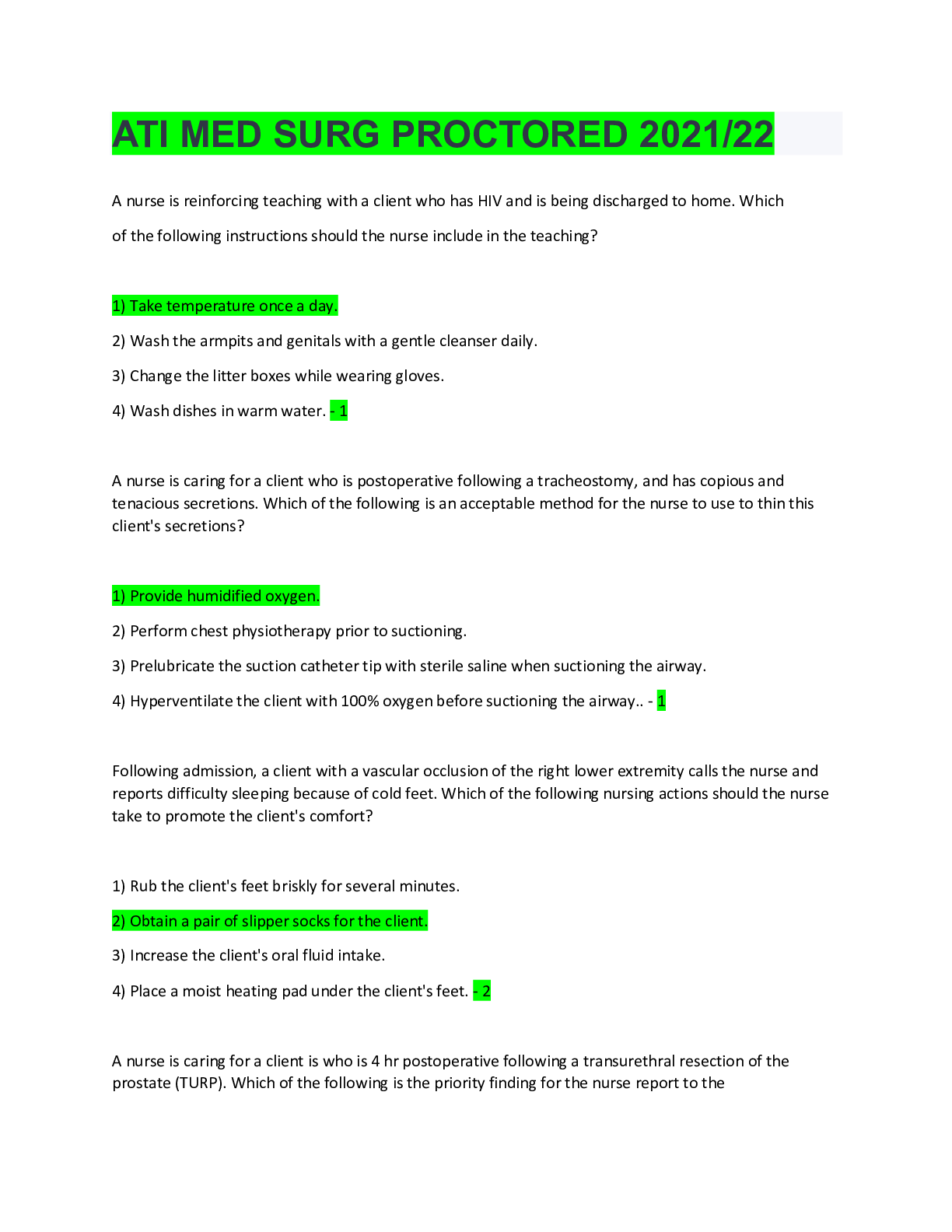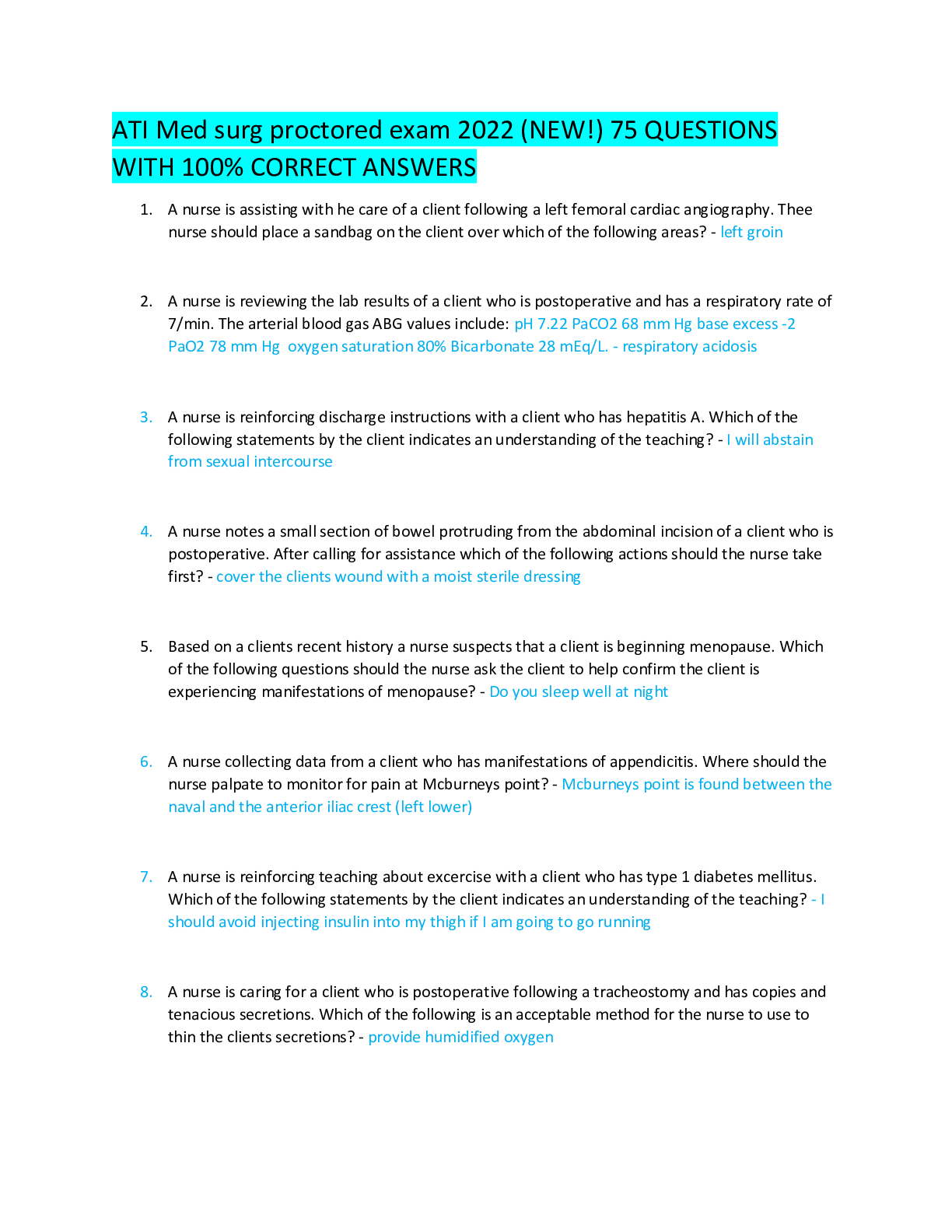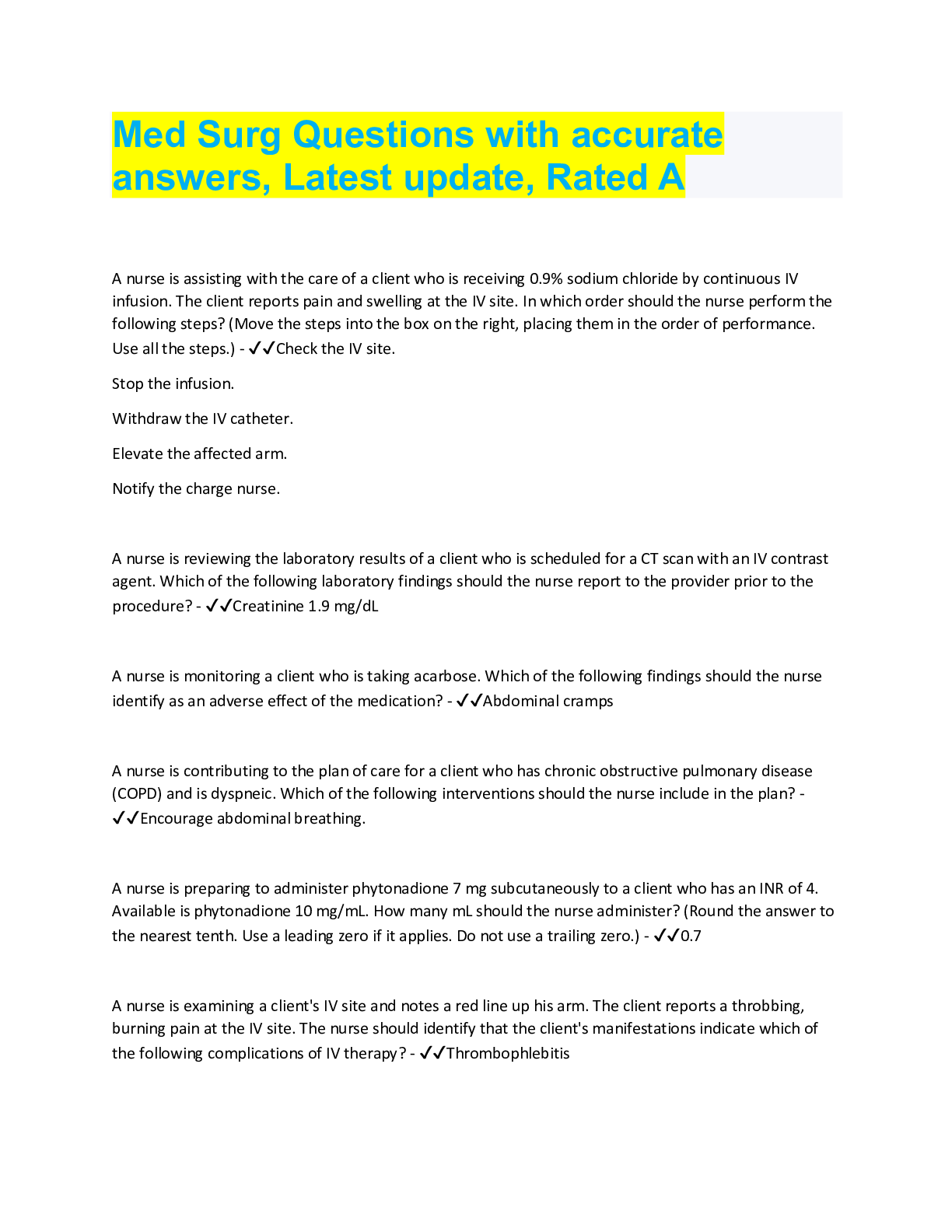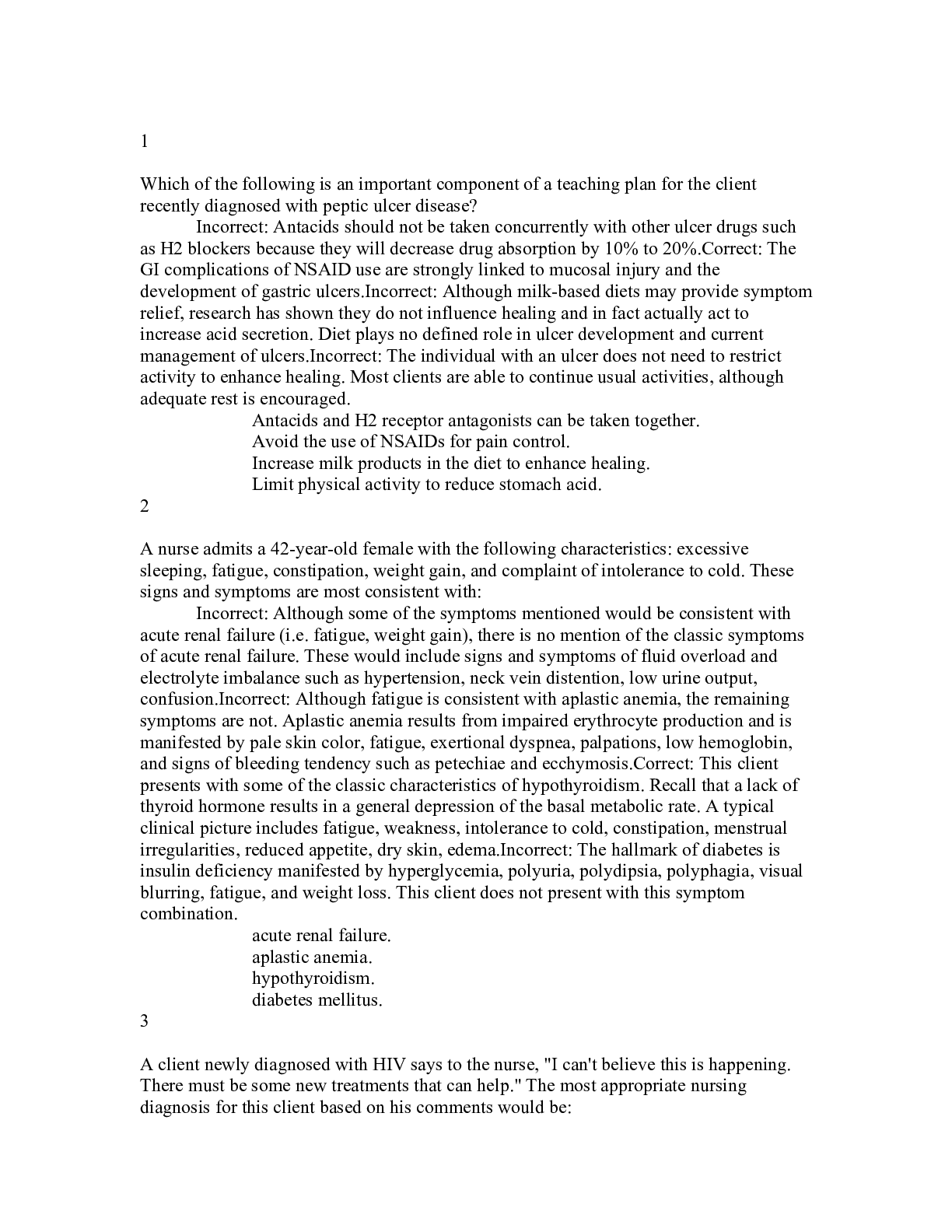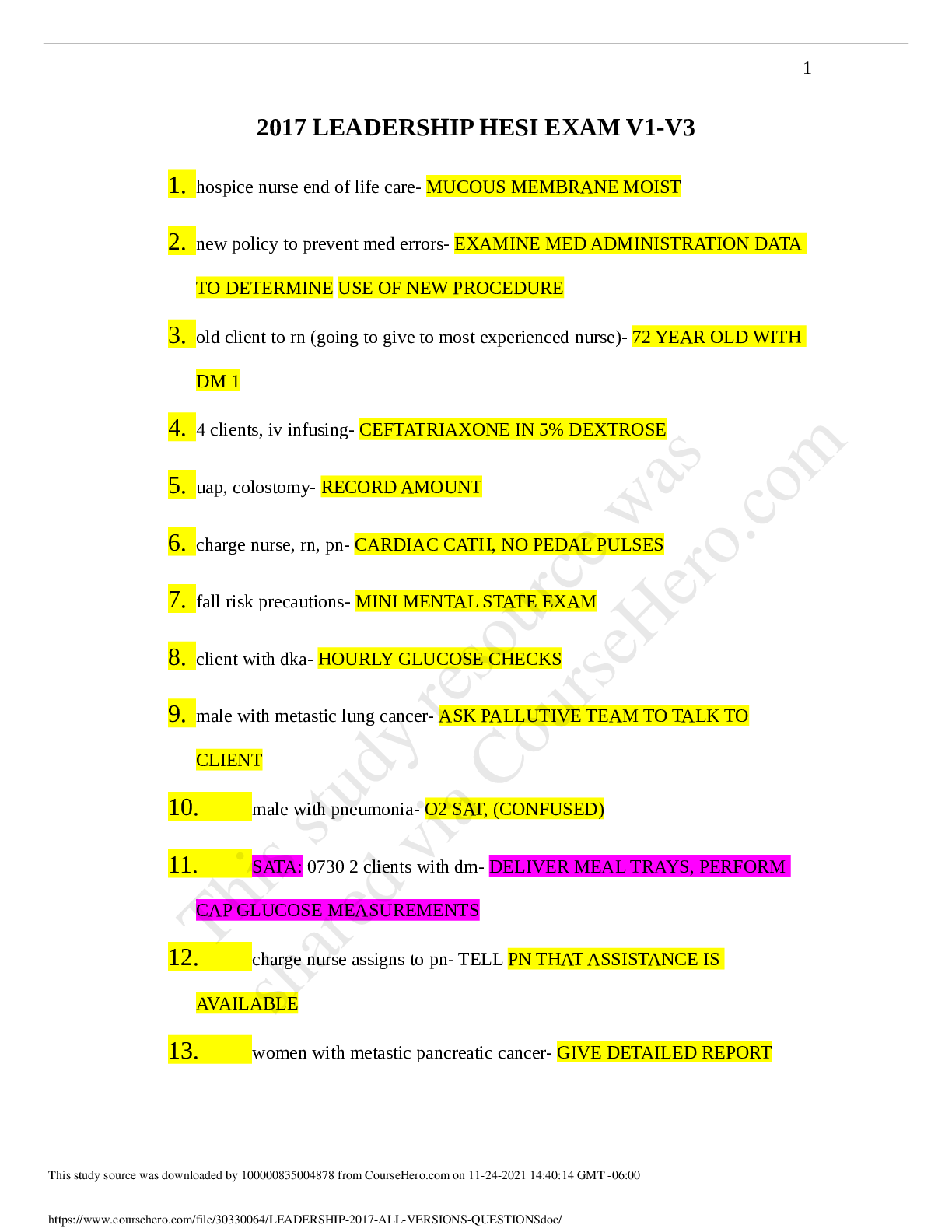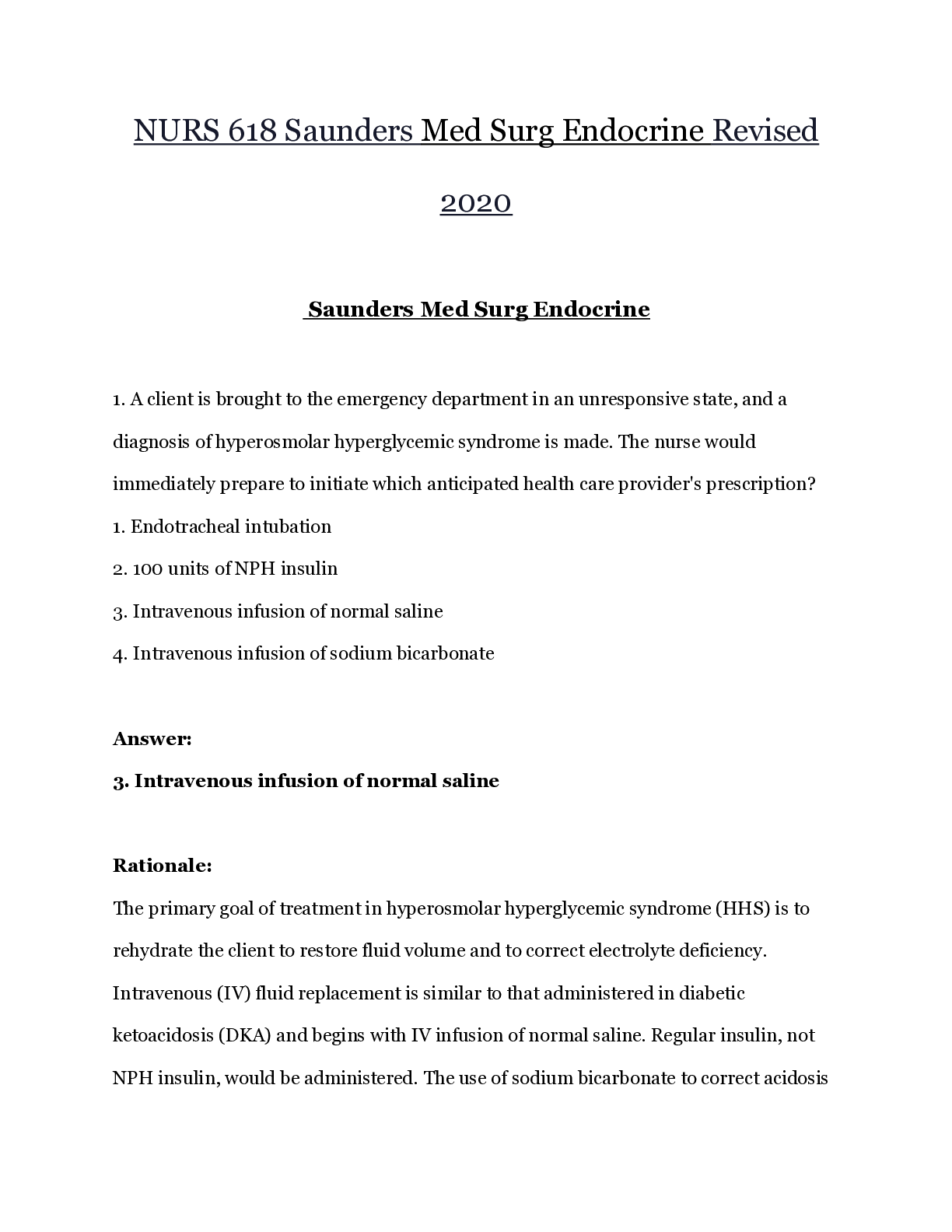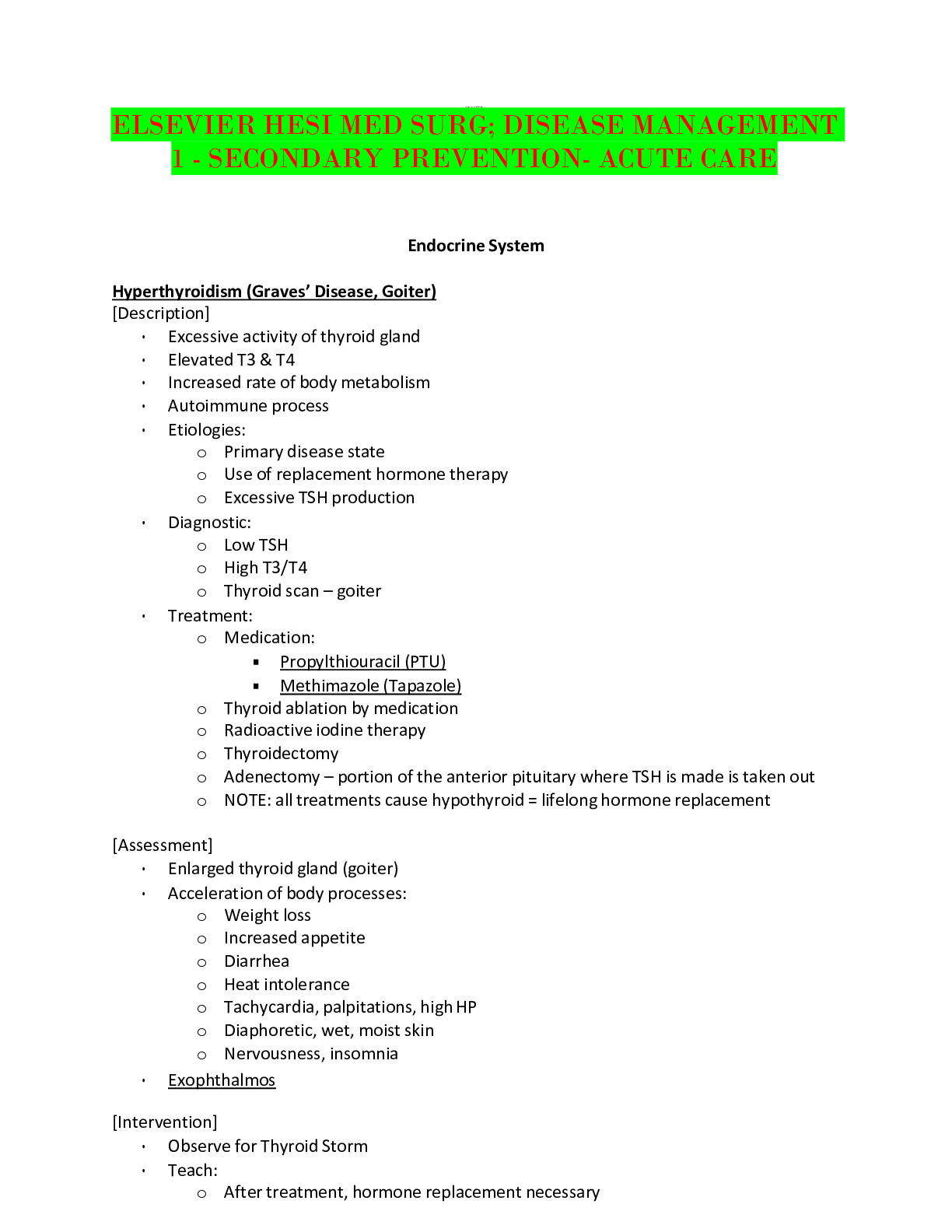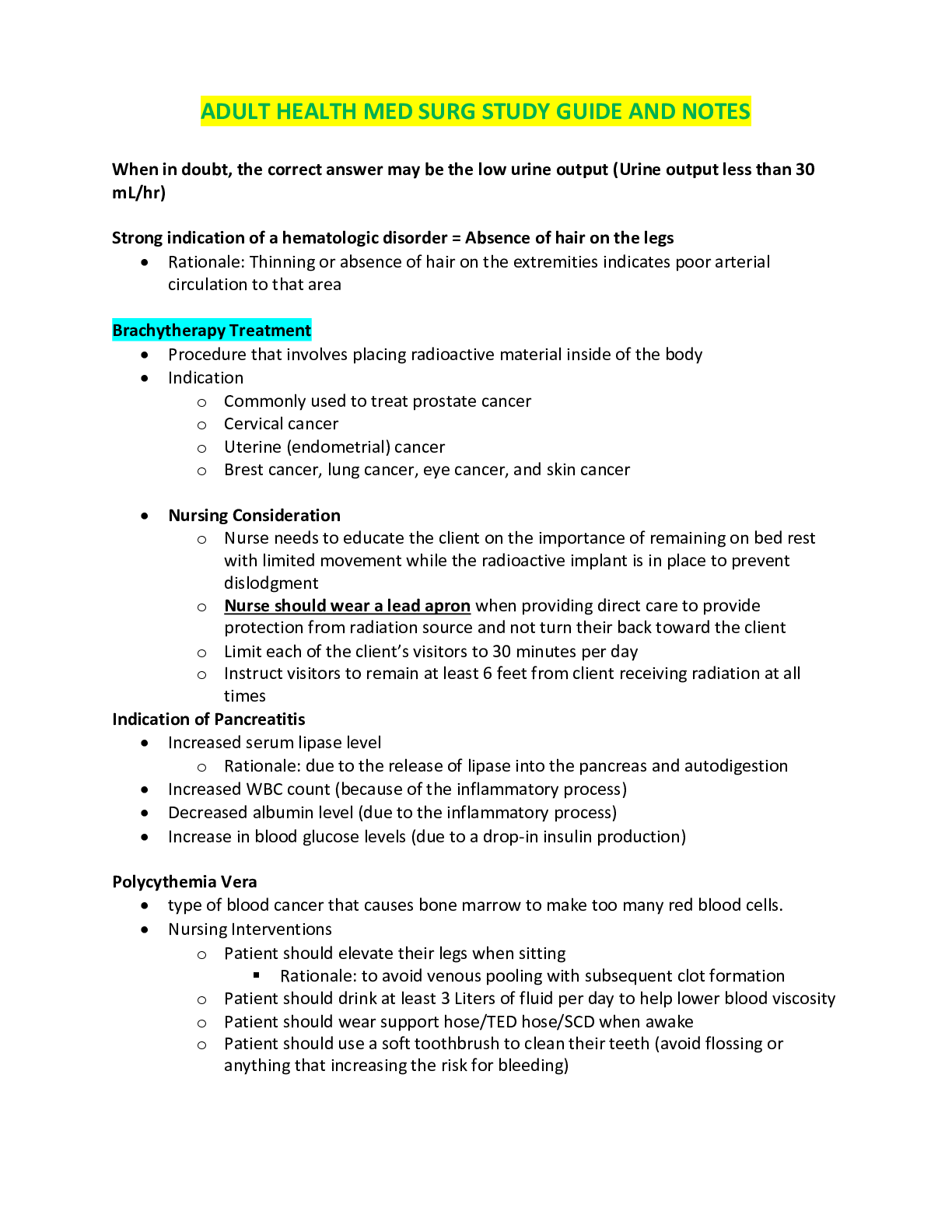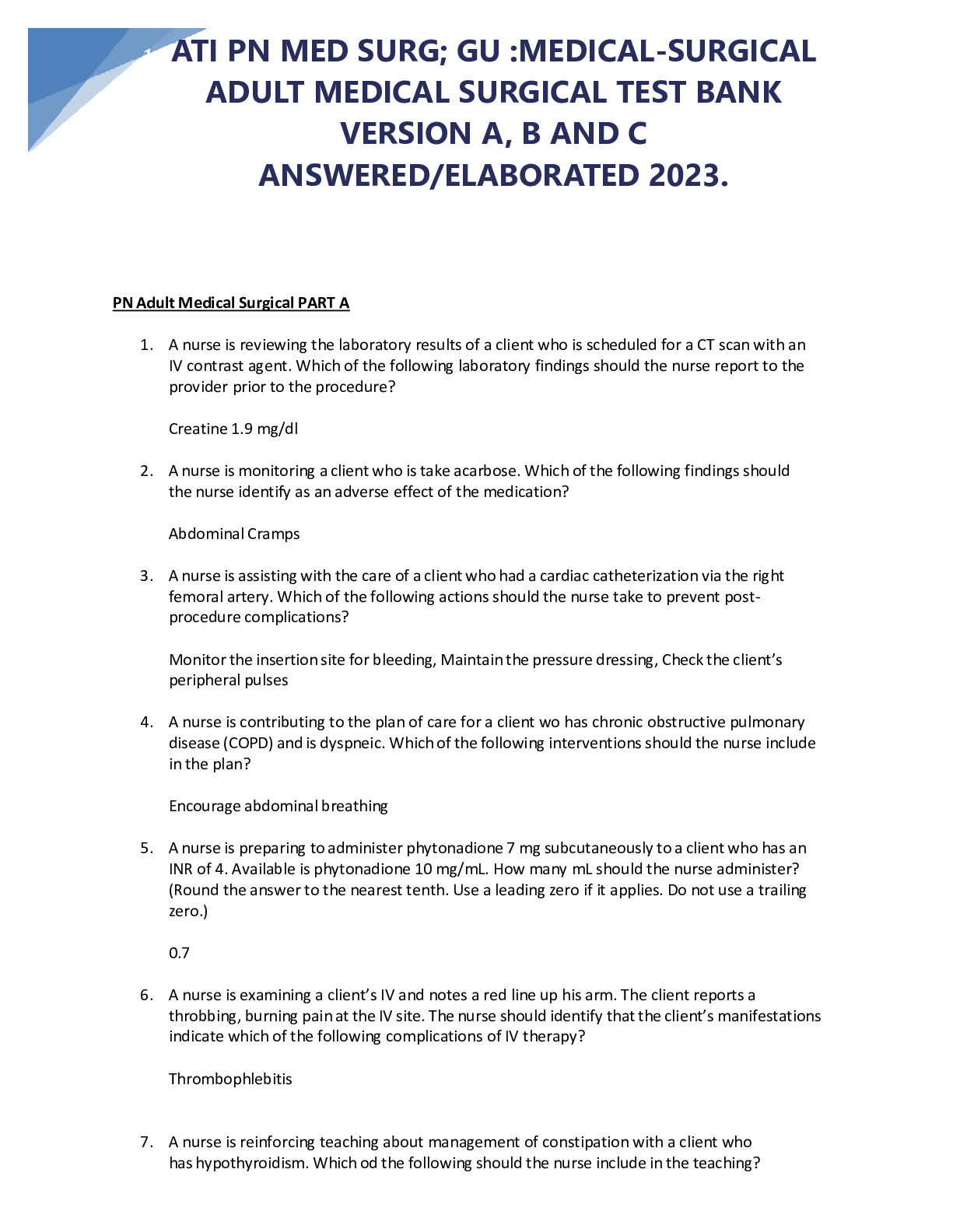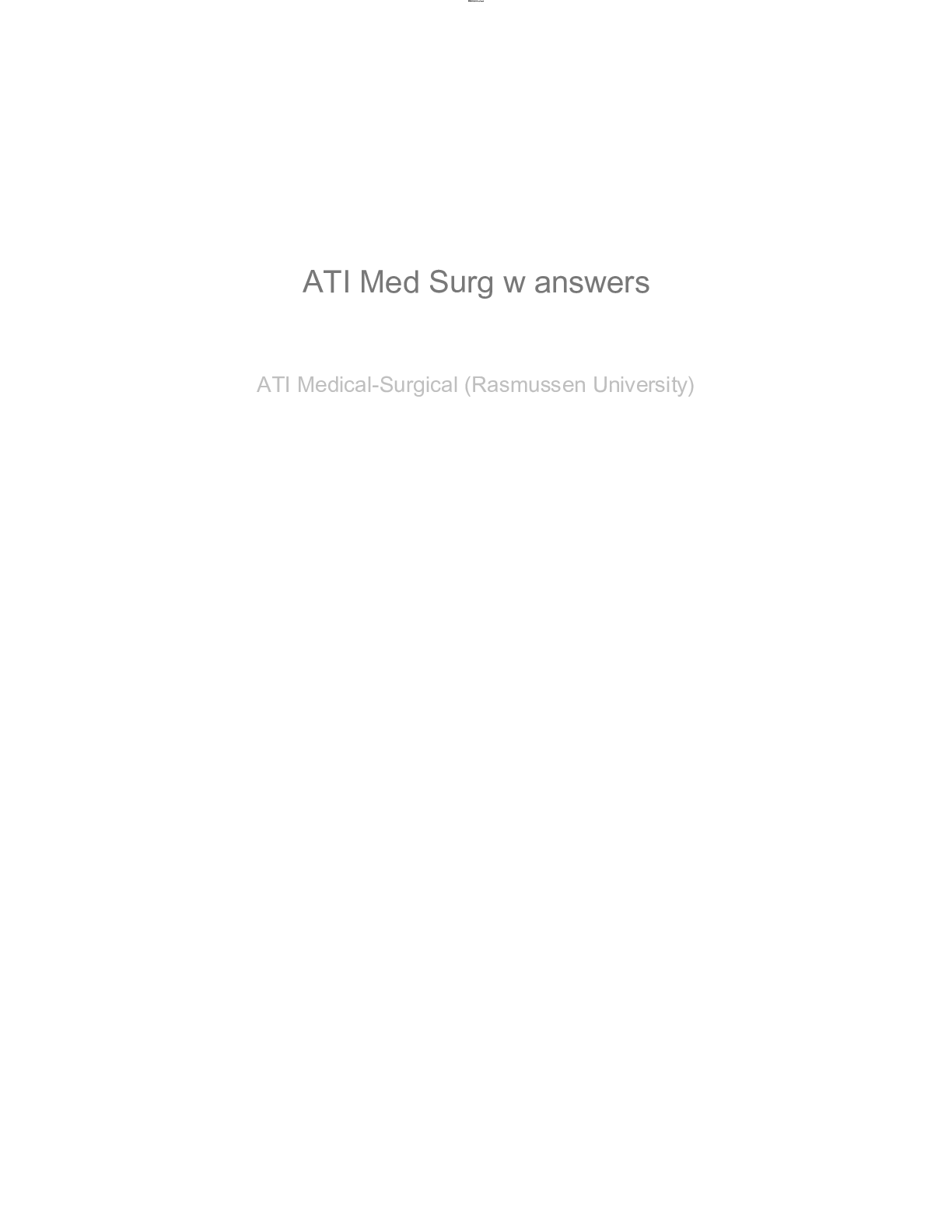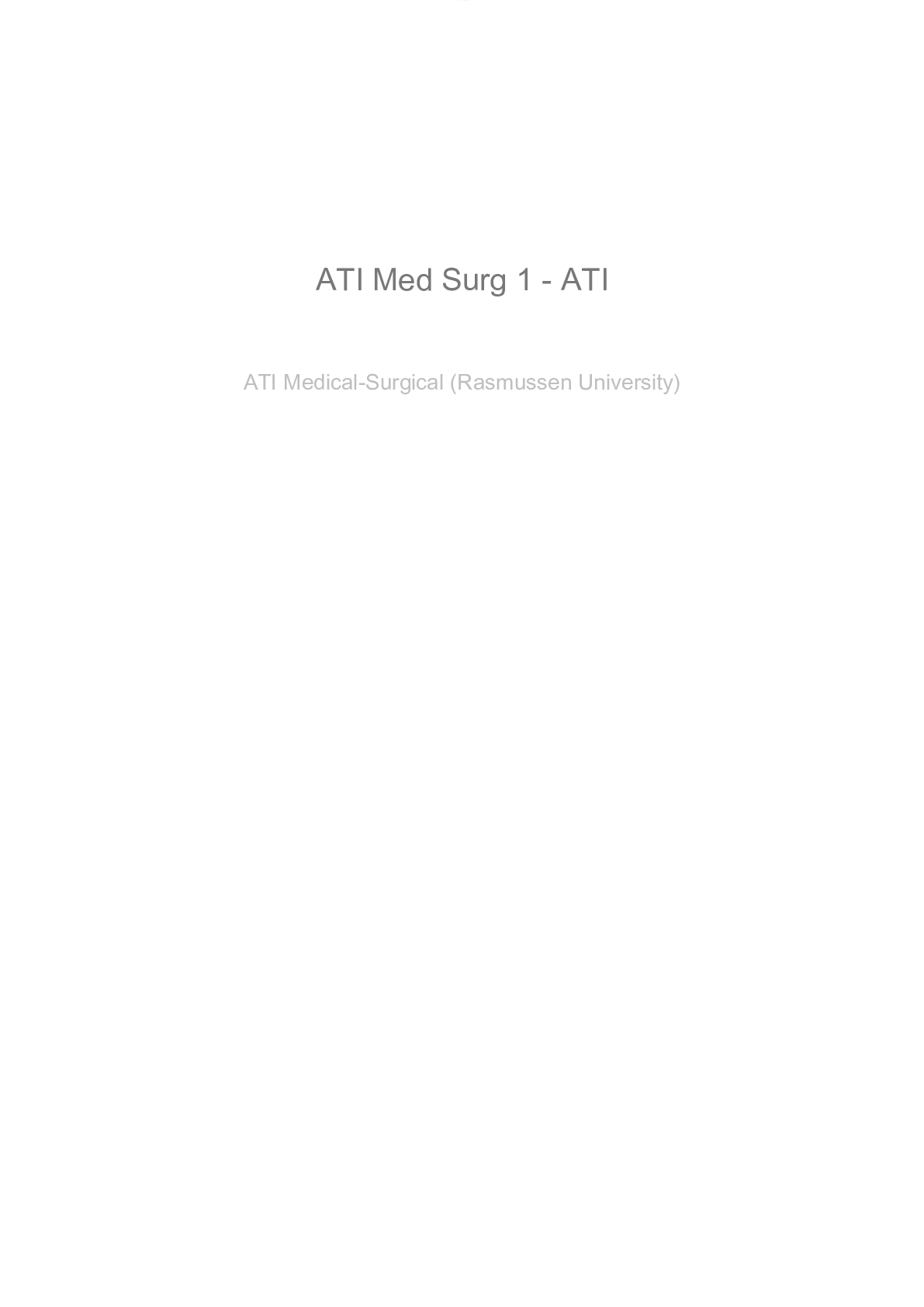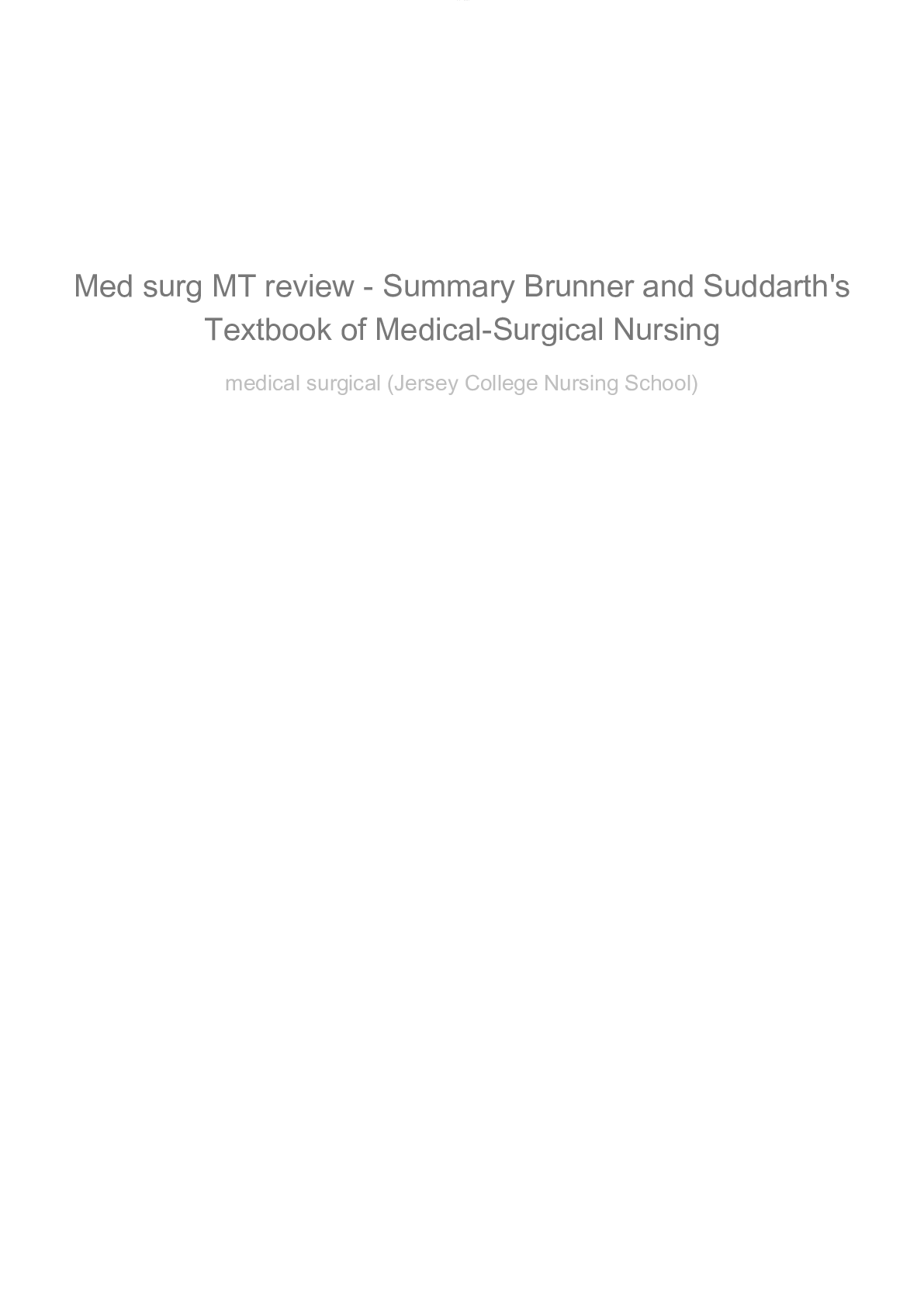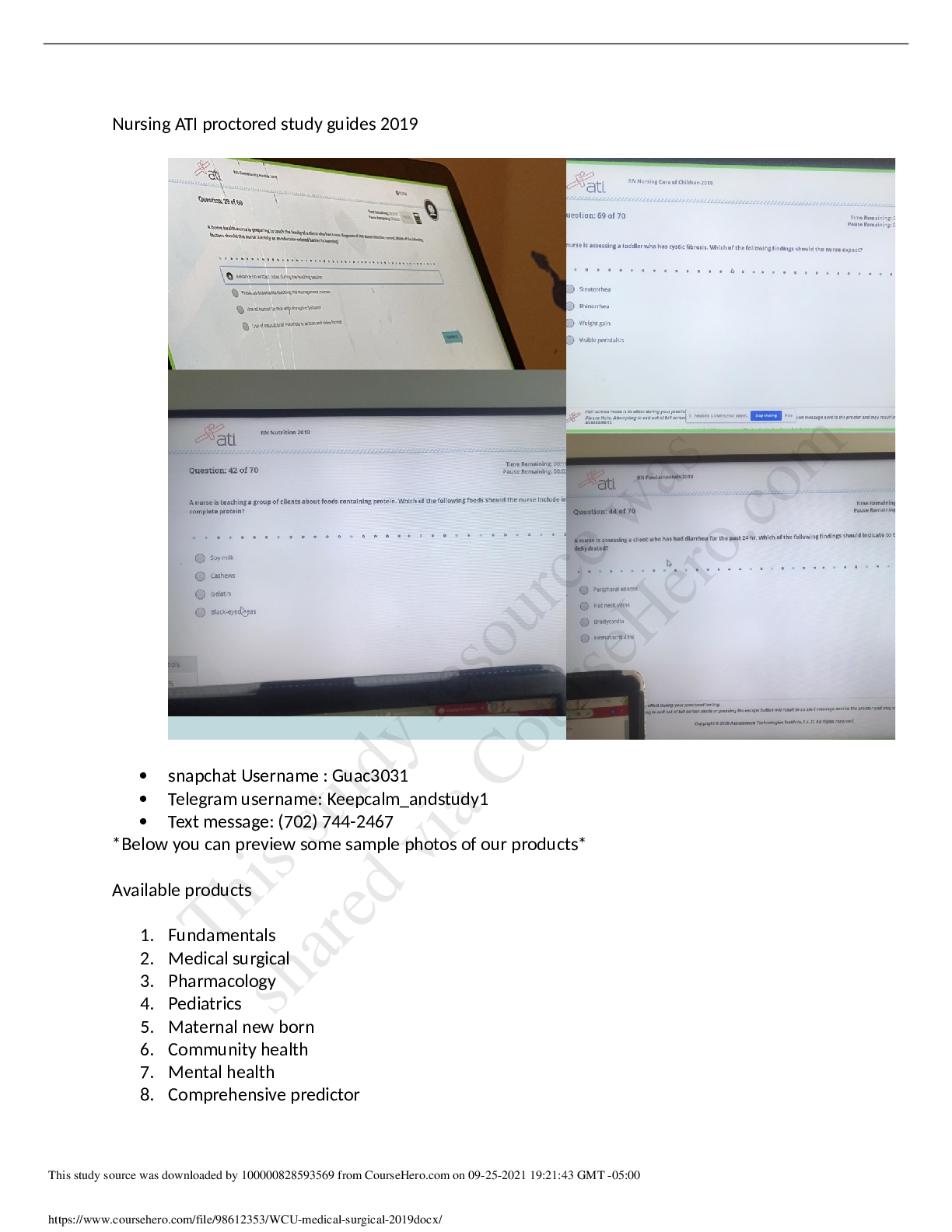*NURSING > MED-SURG EXAM > Medical-Surgical: Immune and Infectious Quiz with Answers and Rationales. Rated A+ (All)
Medical-Surgical: Immune and Infectious Quiz with Answers and Rationales. Rated A+
Document Content and Description Below
A nurse is caring for a client who has human immunodeficiency virus (HIV). The client asks the nurse, "Should I tell my partner that I am HIV positive?" Which of the following statements should the nu... rse give? a. "This is your decision alone." b. "I would if I were you." c. "It sounds like you are unsure what to say to your partner." d. 'Your provider is required by law to notify your partner." - Ans-c. "It sounds like you are unsure what to say to your partner." Rationale - This response uses the therapeutic communication tools of clarifying and restatement. It identifies that the client is unsure about if or how to approach the issue of being HIV positive with his partner, a common concern of clients due to fear of rejection. This response shows that the nurse is open to further communication with the client and encourages his expression of feelings. A nurse is assessing a client who has Kaposi's sarcoma. Which of the following findings should the nurse expect? a. A nonproductive cough, fever, and shortness of breath b. lesions of the retina that produce blurred vision. c. Onset of progressive dementia. d. Reddish-purple skin lesions. - Ans-d. Reddish-purple skin lesions Rationale - Kaposi's sarcoma is commonly associated with AIDS and manifests as hyper-pigmentated multi centric lesions that can be firm, flat, raised, or nodular. Following biopsy, the lesions are treated with radiation and/or chemotherapy. A nurse is caring for a client who had radioallergosorbent (RAST) testing completed due to seasonal allergies. The nurse should anticipate an elevation in which of the following laboratory tests? a. IgM b. IgA c. IgG d. IgE - Ans-d. IgE Rationale - RAST testing involves measuring the quantity of IgE present in serum after exposure to specific antigens selected on a basis of the client's symptom history. An elevated IgE indicates a positive response and is common among clients who have a history of allergic manifestations, anaphylaxis, and asthma. A nurse is caring for a client who is 2 days postoperative. Which of the following findings should alert the nurse that the client is developing an infection? a. Temperature 37.8 C (100 F) b. Erythema at the incision site c. WBC count 9,000/mm^3 d. Pain reported as 6 on a scale of 0 to 10. - Ans-b. Erythema at the incision site. Rationale - Redness, or erythema, at the incision site is an initial sign of a wound infection and requires intervention by the nurse. A nurse is teaching a client who was recently diagnosed with Raynaud's disease about preventing the onset of manifestations. Which of the following statements by the client indicates an understanding of the teaching? a. "I should limit my exposure to sunlight." b. "I should avoid drinking alcohol." c. "I should not smoke." d. "I should limit my intake of foods high in purine." - Ans-c. "I should not smoke." Rationale - Raynaud's disease is a disorder of the blood vessels that supply blood to the skin and cause the distal extremities to feel numb and cool in response to cold temperatures or stress. During a Raynaud's attack, these arteries narrow, limiting blood circulation to affected areas. Strong emotion or exposure to the cold causes these areas to become white, due to a lack of blood flow in the area. They then turn blue, as tiny blood vessels dilate to allow more blood to remain in the tissues. When the flow of blood returns, the area becomes red and then later returns to normal color. This can cause tingling, swelling, and painful throbbing. The attacks can last from minutes to hours. If the condition progresses, blood flow to the area could become permanently decreased, causing the fingers to become thin and tapered, with smooth, shiny skin and slow-growing nails. If an artery becomes blocked completely, gangrene or ulceration of the skin can occur. Smoking cessation, not just reduction, is an action the client should take to prevent the onset of the manifestations of Raynaud's disease. A nurse is assessing a client who has systemic scleroderma. Which of the following findings should the nurse expect? a. Excessive salivation b. Finger contractures c. Periorbital edema d. Alopecia - Ans-b. Finger contractures Rationale - Scleroderma is a chronic disease that can cause thickening, hardening, or tightening of the skin, blood vessels, and internal organs. There are two types of scleroderma: localized scleroderma, which mainly affects the skin, and systemic scleroderma, which can affect internal organs. The manifestations include skin changes, Raynaud's phenomenon, arthritis, muscle weakness, and dry mucous membranes. With scleroderma, the body produces and deposits too much collagen, causing thickening and hardening. In addition to the client's skin and subcutaneous tissues becoming increasingly hard and rigid, the extremities stiffen and lose mobility. Contractors develop with advanced systemic scleroderma unless clients follow a regimen of range-of-motion and muscle-strengthening exercises. A nurse is caring for a client who has systemic lupus erythematosus (SLE) and is concerned about the skin lesions on her face and neck. The client asks the nurse, "What should I do about these spots?" Which of the following responses should the nurse give? a. "Keep the lesions covered with a light sterile dressing when going outside." b. "Rub lesions with a washcloth to dry after washing." c. "Apply moisturizer after bathing the lesions with warm water." d. "Apply antibiotic cream twice per day until scabs form on the lesions." - Ans-c. "Apply moisturizer after bathing the lesions with warm water." Rationale - The nurse should instruct the client to clean, dry, and moisturize the skin using warm (not hot) water, along with an unscented lotion. A nurse teaching a client who has human immunodeficiency virus about how the virus is transmitted. Which of the following statements should the nurse include in the teaching? a. "HIV can be transmitted as soon as a person develops manifestations." b. "HIV can be transmitted to anyone who has had contact with the infected blood." c. "HIV is transmitted through the respiratory route through droplets." d. "HIV is transmitted only during the active phase of the virus." - Ans-b. "HIV can be transmitted to anyone who has had contact with the infected blood." Rationale - The concentration of the virus is highest in blood but also has been isolated in other body fluids, including sputum, saliva, cerebrospinal fluid, urine and semen. Clients who have HIV are cautioned to practice safe sex, avoid donating blood, and abstain from sharing needles with others. A nurse is caring for a client who has human immunodeficiency virus. Which of the following types of isolation should the nurse implement to prevent transmission of HIV? a. Protective isolation b. Droplet isolation c. Standard isolation d. Airborne isolation - Ans-c. Standard isolation Rationale - Standard precautions should be implemented with every client, to prevent the spread of infection transmitted by direct or indirect contact with infectious blood or body fluids. Because HIV is spread through blood and bodily fluid, standard precautions are appropriate. A nurse is teaching a client who has tested positive for an allergy to dust. The nurse should determine that the client understands how to reduce her exposure to this allergen when she states which of the following? a. "I will begin vacuuming once a week." b. Carpeting the entire hose will be very expensive, but it will be worth it." c. I will apply a mattress cover to my bed." d. "Installing curtains on my windows will help control the dust in the house." - Ans-c. "I will apply a mattress cover to my bed." Rationale - The nurse should instruct the client to apply a hypoallergenic mattress cover that can be zipped over her bed to control the amount of dust. The client should remove the mattress cover periodically and machine wash to clean. A nurse is caring for a client who is experiencing an acute exacerbation of rheumatoid arthritis. The nurse should anticipate that the client's affected joints will require which of the following treatments? a. An assistive device to use when the client is ambulating. b. Heat paraffin therapy applied to client's joints. c. Gentle massage of the client's hands. d. Active range-of-motion exercises on the client's affected joints. - Ans-b. Heat paraffin therapy applied to client's joints. Rationale - The nurse should anticipate the use of heat paraffin to be prescribed as a non-pharmacologic intervention. The elevated ESR indicates an acute inflammatory process due to client's rheumatoid arthritis. The use of the warm paraffin relieves the stiffness of the client's joints and provides comfort. [Show More]
Last updated: 1 year ago
Preview 1 out of 10 pages

Reviews( 0 )
Document information
Connected school, study & course
About the document
Uploaded On
Jun 17, 2022
Number of pages
10
Written in
Additional information
This document has been written for:
Uploaded
Jun 17, 2022
Downloads
0
Views
61

